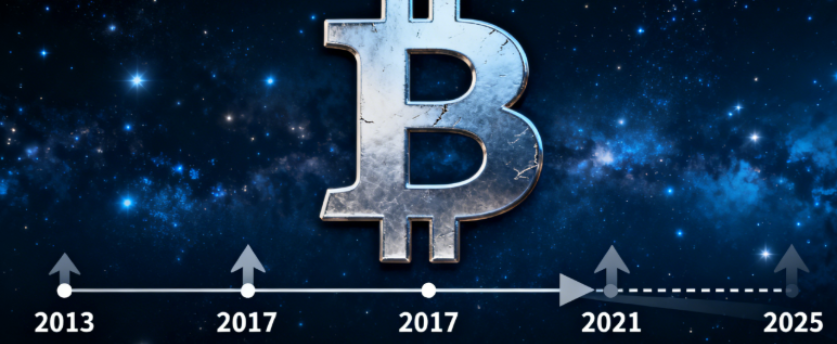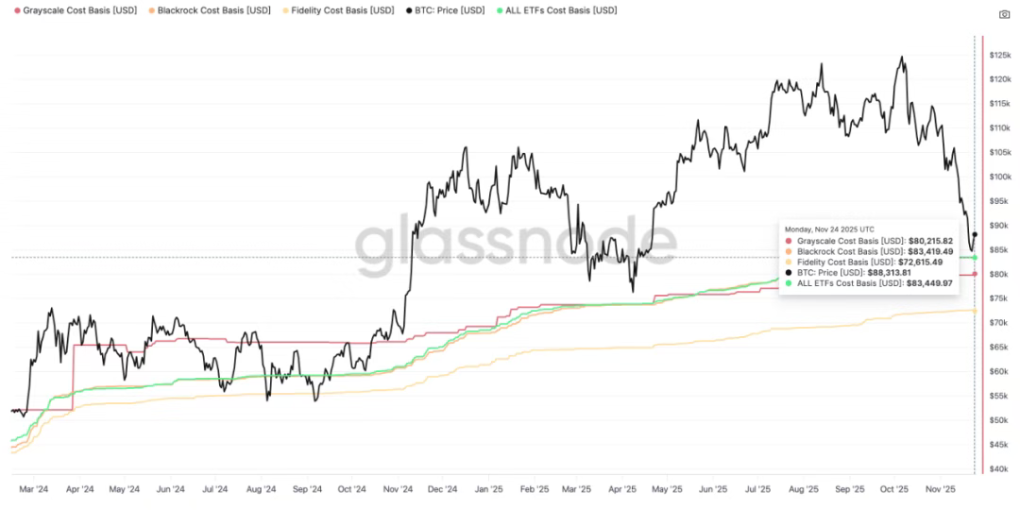From mining mechanisms to capital flows, the game rules of Bitcoin have changed.
"The previous four-year halving cycle of Bitcoin has ended and has now been replaced by a two-year cycle." This viewpoint by Bitwise advisor Jeff Park has sparked widespread attention in the cryptocurrency market.
In the past, Bitcoin's price movements followed a four-year cycle driven by halving events. This mechanism was effective because it combined predetermined supply shocks with a market herd effect that could be reliably triggered.
Now, this traditional cycle is being broken.

1. Old Cycle: Resonance of Halving Mechanism and Market Psychology
In Bitcoin's early design, Satoshi Nakamoto created artificial scarcity through the halving mechanism. Every 210,000 blocks mined (approximately four years), the rewards for miners would be halved.
● From 50 to 25, then to 12.5, 6.25, and now down to 3.125 BTC. This design mirrors the natural scarcity of precious metals like gold, endowing Bitcoin with anti-inflation properties. Halving events directly tighten the supply of new Bitcoins, while squeezing miners' profit margins.
● Weaker miners are forced to exit the market, thereby alleviating selling pressure.
● Looking back at history, each halving has indeed led to a price surge.
In the first halving in 2012, BTC was only $12.35, and six months later it rose to $127;
Around the second halving in 2016, BTC was about $650, and 150 days later it approached $760.
● Miners are the key players in this cycle. Their actions directly affect market supply—when rewards are halved and prices do not rise correspondingly, inefficient miners face shutdown pressures.

2. New Cycle: Dominance of ETFs and Institutional Capital
The structure of the Bitcoin market has fundamentally changed. The traditional four-year cycle is being replaced by a two-year cycle, driven by the economic behaviors of institutional fund managers and the flow of ETF capital.
● The approval of the U.S. spot Bitcoin ETF has led to a massive influx of institutional capital, creating unprecedented demand shocks. The operational logic of these institutional funds is vastly different from that of traditional cryptocurrency investors.
● Fund managers face performance settlement pressures every December 31, needing to confirm profits before the year ends. This calendar-year-based assessment cycle significantly impacts their investment decisions.
● When fund managers build positions at a certain price, they calculate the investment return targets they need to achieve in the next one to two years. If Bitcoin's price does not fluctuate but time continues to pass, it is actually unfavorable for institutional investors, as their annualized investment returns will decline over time.
3. Supply-Demand Imbalance: Core Driver of Bitcoin's Long-Term Growth
Ongoing supply-demand imbalances are key factors driving Bitcoin's long-term growth. After halving, the daily mining output of Bitcoin has decreased to about 450 coins. Meanwhile, demand is experiencing explosive growth.
● By 2025, funds and ETFs are expected to purchase an average of 1,430 Bitcoins daily, with corporations being the largest net buyers, averaging about 1,755 coins per day. This figure far exceeds the daily issuance.
● Institutional purchasing power creates a significant supply-demand imbalance. On a certain day in August 2025, the net inflow was about three times the mining output for that day.
● With 95% of the total Bitcoin supply already in circulation, and issuance slowing further after each halving, the new supply is steadily decreasing while demand sources are diversifying and institutionalizing.
This ongoing supply tightening may provide strong support for Bitcoin's price in the coming years.
4. Volatility Return: Increasing Impact of the Options Market
Bitcoin's volatility has recently seen a significant rise for the first time since 2025, signaling that the market may again enter options-driven price behavior. As of November 26, 2025, data shows an astonishing scale of open options contracts on the Deribit platform.
● The open contracts for put options with a strike price of $85,000 expiring on December 26 reached $1 billion; during the same period, the open contracts for call options with a strike price of $140,000 also reached $950 million. The existence of these large-scale options positions can itself influence market price movements.
● Dynamic hedging operations conducted by traders to hedge risks may exacerbate market volatility, creating a self-fulfilling prophecy. Even during periods of falling spot prices, Bitcoin's implied volatility (IV) continues to rise.
This divergence indicates that the market is pricing in significant volatility—regardless of direction.

5. Miners' Dilemma: A Reflection of the Transition Between Old and New Cycles
Miners, as the cornerstone of the Bitcoin network, are at the vortex of the transition between old and new cycles. Currently, the Bitcoin mining industry is in distress. Over the past two months, the average weekly miner revenue has dropped by 35% from $60 million to $40 million.
● Miners face dual pressures: on one hand, Bitcoin's price has fallen about 30% from its peak to around $86,000; on the other hand, network hash rate has reached a record high of 1,078 Exahashes/second (EH/s).
● Rough estimates suggest that large publicly listed mining companies like Marathon Digital have a total mining cost exceeding $110,000 for each BTC mined. This means that at current prices, many miners are already below their economic breakeven point.
● Miners are forced to adjust their strategies—an increasing number of miners are choosing to hold the BTC they mine or even purchase more BTC from the market rather than sell.
● As long as miners maintain positive cash flow, they will continue to mine, but under price pressure, the overall network hash rate may face adjustments.

6. New Investment Strategies: Adapting to the Changing Bitcoin Market
In the face of changing market structures, investors need to adjust their strategies. The traditional "buy and hold" strategy remains effective but may not be the optimal choice. Understanding institutional capital flows has become key.
The cost basis of institutional investors has become a critical price level.
● AiCoin data shows that the current price level of Bitcoin, close to $84,000, is the total cost basis for all inflows into ETFs so far. This means that any volatility deviating from this level could trigger strong reactions from institutions.

Investors should pay attention to on-chain signals to understand demand/supply changes.
● Inflows to exchanges represent an increase in supply (potential selling pressure), while outflows from exchanges indicate an increase in demand (greater holding willingness). Large purchases by whale addresses are also significant demand signals.
Options market data also provides valuable insights.
● Concentrated strike prices of open contracts often become price magnets, as traders need to dynamically hedge their positions.
The game rules of Bitcoin have indeed changed, but they have not become chaotic. The traditional four-year cycle is gradually fading from dominance, while the new two-year cycle is being shaped by institutional capital flows and the economic behaviors of fund managers.
"Prices always depend on marginal demand and marginal supply, as well as profit-seeking behavior," but the buyers have shifted from retail to institutional, while the importance of supply itself has diminished.
The good news is: these buyers, as agents of others' funds, behave more predictably; and the weakening of supply constraints means that more predictable factors will dominate.
Join our community to discuss and grow stronger together!
Official Telegram community: https://t.me/aicoincn
AiCoin Chinese Twitter: https://x.com/AiCoinzh
OKX benefits group: https://aicoin.com/link/chat?cid=l61eM4owQ
Binance benefits group: https://aicoin.com/link/chat?cid=ynr7d1P6Z
免责声明:本文章仅代表作者个人观点,不代表本平台的立场和观点。本文章仅供信息分享,不构成对任何人的任何投资建议。用户与作者之间的任何争议,与本平台无关。如网页中刊载的文章或图片涉及侵权,请提供相关的权利证明和身份证明发送邮件到support@aicoin.com,本平台相关工作人员将会进行核查。




